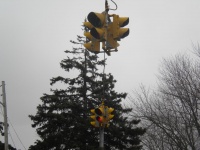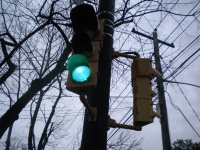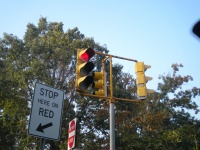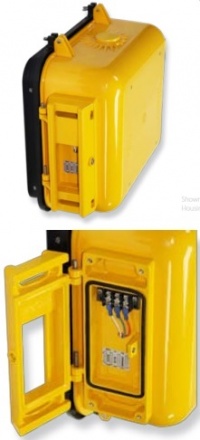Difference between revisions of "Signal Mounting Styles"
m |
|||
| Line 5: | Line 5: | ||
<br clear=all> | <br clear=all> | ||
=Gooseneck Hangers= | =Gooseneck Hangers= | ||
| + | [[File:Winkobeaconpyth.jpg|200px|thumb|Right|A [[Winko-Matic]] beacon held up by a gooseneck hanger and a spanwire clamp.]] | ||
Usually seen with cluster hardware, gooseneck hangers are hollow aluminum(usually?) hangers with multiple holes along the top. The general idea of them is to allow a mounting point for signals and clusters that can sway slightly, hold a lot of weight, and provide a water-resistant entry point for wires to reach the signals. The multiple holes along the tops allow for pivotal adjustments to help counter-balance any weight offsets from clusters. | Usually seen with cluster hardware, gooseneck hangers are hollow aluminum(usually?) hangers with multiple holes along the top. The general idea of them is to allow a mounting point for signals and clusters that can sway slightly, hold a lot of weight, and provide a water-resistant entry point for wires to reach the signals. The multiple holes along the tops allow for pivotal adjustments to help counter-balance any weight offsets from clusters. | ||
| + | <br clear=all> | ||
=Spanwire Sign Brackets= | =Spanwire Sign Brackets= | ||
=Mounting Arms= | =Mounting Arms= | ||
| − | [[File:Winkobracketspyth.jpg|200px|thumb|right|12-8-8 | + | [[File:Winkobracketspyth.jpg|200px|thumb|right|12-8-8 Winko-Matics mounted to a pole with mounting arms.]] |
Utilizing the same pipes and junctions as above, this mounting style also features special junction pieces that generally fit smoothly against poles, and are then held on to the pole itself with metal bands. Wiring can then be run through the pole or along the outside, into the arms and then into the signal. | Utilizing the same pipes and junctions as above, this mounting style also features special junction pieces that generally fit smoothly against poles, and are then held on to the pole itself with metal bands. Wiring can then be run through the pole or along the outside, into the arms and then into the signal. | ||
<br clear=all> | <br clear=all> | ||
Revision as of 04:08, 18 February 2014
Out in the field, signals are always mounted to some solid object to keep them high up and less likely to be vandalized.
Contents
Cluster Pipes & Junctions

More often than not, signals will be found in clusters, or groups of 2 or more seperate signals held together by conduit-style piping and junctions. Wire is run from the cabinet, through these pipes and junctions, into the signals directly. These hardware examples are more commonly found with spanwire setups, and uncommonly seen with pole-mounted signals. The general pipe size today is 1½" diameter, but in the past sizes varied from 1¼" to 2" diameters. Many signal companies have also produced cluster hardware, such as Crouse-Hinds, Eagle, and Marbelite.
Gooseneck Hangers
Usually seen with cluster hardware, gooseneck hangers are hollow aluminum(usually?) hangers with multiple holes along the top. The general idea of them is to allow a mounting point for signals and clusters that can sway slightly, hold a lot of weight, and provide a water-resistant entry point for wires to reach the signals. The multiple holes along the tops allow for pivotal adjustments to help counter-balance any weight offsets from clusters.
Spanwire Sign Brackets
Mounting Arms
Utilizing the same pipes and junctions as above, this mounting style also features special junction pieces that generally fit smoothly against poles, and are then held on to the pole itself with metal bands. Wiring can then be run through the pole or along the outside, into the arms and then into the signal.
Astro-Brackets
These sleek, modern brackets are usually found with mast arm setups. They generally hold one signal each, but can be found holding 2 signals, or a single doghouse configuration. Wiring is ran through the mast arm, out near the bracket's attachment point, through the bracket, and into the signal. These brackets come in varying heights, and can be adjusted on the job for different signal heights.
Slipfitters
Slipfitters are heavy aluminum pole caps with at least one 1½" hole to allow signals to attach to it, either directly or via cluster hardware. Some slipfitters have offset connection points so signals with backplates don't need extra hardware to fit on properly.
Flag-Mounts
Mainly made by Eagle and Crouse-Hinds, these now-defunct signal attachments allowed signals to horizontally mount to poles, with a small compartment between the two that usually held a terminal strip. These were usually seen with Crouse-Hind's Art Deco signals, and Eagle's Flatback signals. Flag-mounts are very hard to come by these days.
Compact Ped Housing Mounts
Called Clamshell Mounting Hardware by McCain, these compact attachment points allow pedestrian signals to mount almost directly to poles with no extra hardware required, creating a sleek, clean installation.


